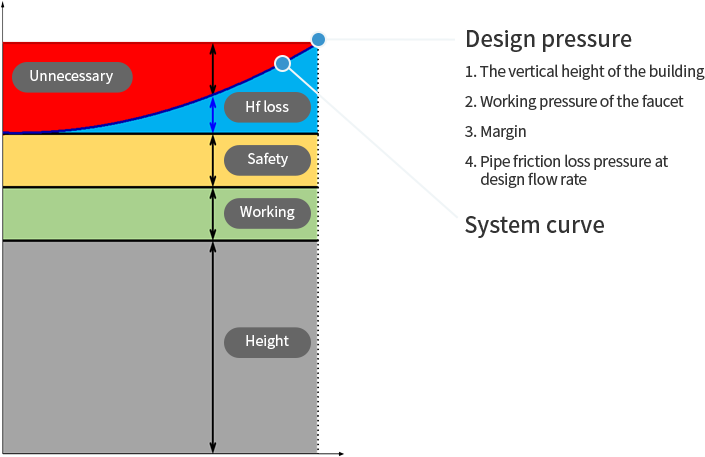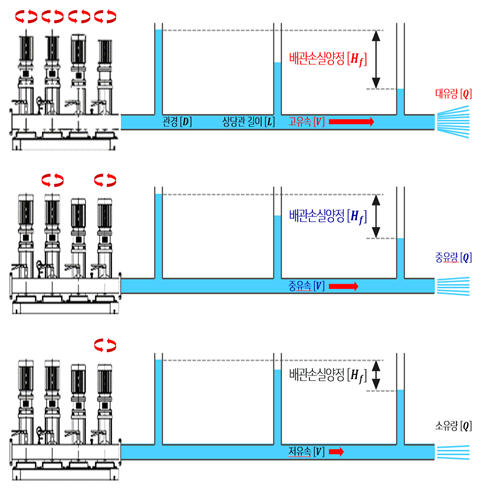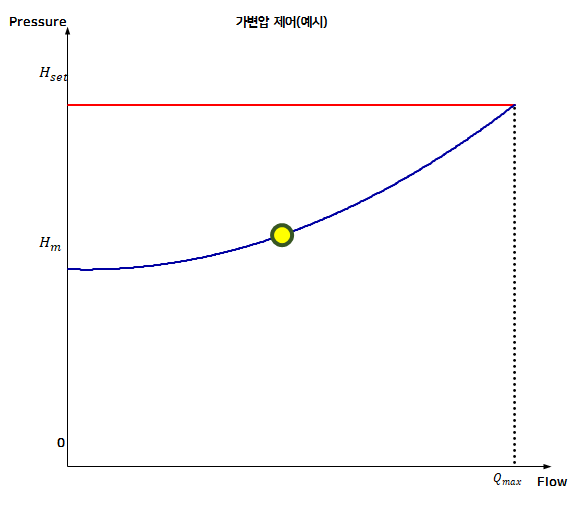Introduction to variable pressure control technology
Description of variable pressure control technology
부스터 펌프 시스템의 토출압 제어 기준이 유량에 따라 달라지는 가변압(배관
마찰손실양정)을 따르도록 제어하는 것.

New technology
-
Implementing variable pressure control considering the friction
loss lift of piping for the first time in Korea/world
-
Automatically calculating the flow rate in the current operating
state (within ±3%)
- New product certification (NEP: NEP-MOTIE-2020-095)

Convenience
-
Automatically calculates the friction loss lift of piping based on
building information
(number of blocks, number of floors, number of households, etc.)
-
Automatic setting of the starting pressure according to the
maximum pressure
-
Converts the friction loss head of the pipe into a pressure
equation for flow and automatically sets it as a variable pressure
reference line
-
Provides information on current flow, accumulated flow, current
power and accumulated power
-
Provides operation information (number of revolutions, operating
hours, etc.) for each pump
-
Preventing hunting and lowering of pressure when switching the
pump, through the implementation of the optimal pump replacement
method

Effect
-
[Power Savings] Power by flow rate is reduced by about 20%
compared to existing products depending on the flow rate
-
[Energy Savings] Power consumption for 24 hours is reduced by
about 20% compared to existing products depending on the place of
use
Change in control method
| Generation |
1st |
2nd |
3rd |
4th (current) |
Control
method |
ON/OFF |
Constant pressure control |
Constant pressure control |
Variable pressure control |
Water supply
method |
고가수조방식 |
급수펌프직송방식 |
급수펌프직송방식 |
급수펌프직송방식 |
| Composition |

|
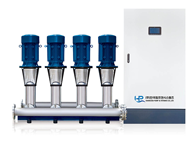
|
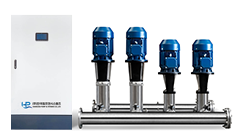
|
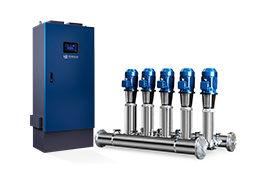
|
| Generation |
3rd |
4th (current) |
Control
method |
Constant pressure control |
Variable pressure control |
Water supply
method |
급수펌프직송방식 |
급수펌프직송방식 |
| Composition |

|

|
How to decide the flow rate (flux) and pressure
| Flux |
Lift |
1. Calculation method by exponential load unit (FU)
2. Calculation method based on the number of instruments and the
rate of simultaneous use
3. Calculation method for water supply in apartment houses
|
1. Vertical height from the water tank to the farthest faucet in
the process of transferring water
2. The total lift is the sum of the actual vertical height and the
loss due to the pipe material, length and diameter of the pipe
converted into vertical height. It is determined by the pressure
generated from the discharge part of the pump.
|
| Lift |
1. Vertical height from the water tank to the farthest faucet in
the process of transferring water
2. The total lift is the sum of the actual vertical height and the
loss due to the pipe material, length and diameter of the pipe
converted into vertical height. It is determined by the pressure
generated from the discharge part of the pump.
|
| Design pressure |
Constant pressure control regardless of
flow rate change as a design pressure
|
| System curve |
A curve that considers pipe friction loss
due to flow, and it is controlled along with this curve
|
| Generation |
Control method |
Control standards |
Control factors |
| 3rd |
Constant pressure control |
Design pressure |
Pressure information |
| 4th (current) |
Variable pressure control |
System curve |
Flow rate information
Pressure information
|
| Control standards |
Control factors |
| Design pressure |
Pressure information |
| System curve |
Flow rate information
Pressure information
|
배관 마찰 손실
| 배관 마찰 손실 |
When the flow passes through the pipe, the pressure is lost
due to friction between
the fluid and the pipe. The more fluid that passes, the
greater the pressure lost.
|
| 배관 마찰 손실 Essential elements for the calculation |
1. The diameter of the pipe
2. Cross-sectional area of pipe
3. Amount of fluid passing through
4. Fluid velocity
5. Reynolds number
6. Friction loss coefficient
|
배관 마찰 손실
Control
standards
|
System curve |
Automatic setting technology |
Control
factors
|
Pressure information,
Flow information
|
Pressure sensor,
Flow rate calculation technology
|
| Benefits |
1. Provides flow information
2. Extends life span of pump and pipe
3. Saves power by more than 20% compared to scheduled
pressure control
|
Variable pressure control
|
Variable pressure baseline automatic setting technology
|
Variable pressure
baseline automatic setting technology
|
1. Enter basic information |
- Enter the number of building blocks, floors, households, area,
maximum flow rate
- Using the Darcy Weisbach/Harzen Williams formula based on the
input value
|
| 2. Enter directly |
- 최고압력(설계압력)과 배관마찰손실양정을 뺀 시작압력을 직접 입력
|
| 3. Set variable pressure baseline |
- Formulate and establish a variable pressure baseline for total
flow
|
| Flow calculation technology |
|
Flow calculation technology
|
1. Performance test |
- Measure all performance of the booster pump system within the
measurable range for the flow rate
|
| 2. Formulation for flow |
- After defining all data with a mathematical formula, load it
into the device
|
| 3. Flow calculation |
- Acquire operation data in real time, substitute it into the
formula, and inversely calculate the flow rate
|
Gain by variable pressure control
-
[Pressure Gain] It refers to the benefit of eliminating
unnecessary pressure. The smaller the flow rate being used,
the greater it will be.
-
[Flow Gain] This is a gain generated by increasing the range of
the flow rate that can be supplied before the maximum interlocking
of the pump. There will be a section in which processing can be
performed even when only one unit is driven, where two units must
be operated if under constant pressure control.
-
[Power savings] You can save power through pressure gain and flow
gain.
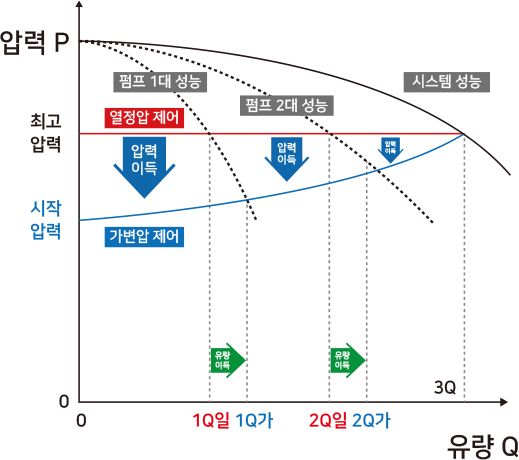
Power Savings Effect
Total
power
|
Pump
configuration
|
Flow
[$m^3/min$]
|
Power[kW] |
Reduction rate
[%] |
Reduction rate
[%] |
| Variable pressure control |
Constant pressure control |
6
kW |
대소
용량
|
0.04
~
0.2
|
0.95
~
4.86
|
1.66
~
5.43
|
20.9 |
21.0 |
동일
용량
|
1.06
~
4.58
|
1.86
~
5.46
|
27.5 |
33
kW |
대소
용량
|
0.15
~
0.1
|
3.10
~
24.52
|
3.76
~
28.52
|
22.1 |
동일
용량
|
3.21
~
26.70
|
4.95
~
31.32
|
23.3 |
88
kW |
대소
용량 |
0.4
3.04 |
8.87
~
72.80
|
10.99
~
76.45
|
15.3 |
동일
용량
|
12.21
~
77.45
|
14.90
~
77.42 |
16.9 |
| Field test |
| Number of households |
540 households |
Number of floors |
20 Floors (1 floor in Basement) |
| Power |
37 kW |
Number of floors using power |
B1 ~ 7 above ground level |
Test
results
(30days)
|
Classification |
Variable pressure control |
Constant pressure control |
Reduction rate [%] |
| Total flow amount |
1,806 |
1,813 |
- |
| Integrated electricity amount of electricity |
1,039 |
1,316 |
21.1 |








